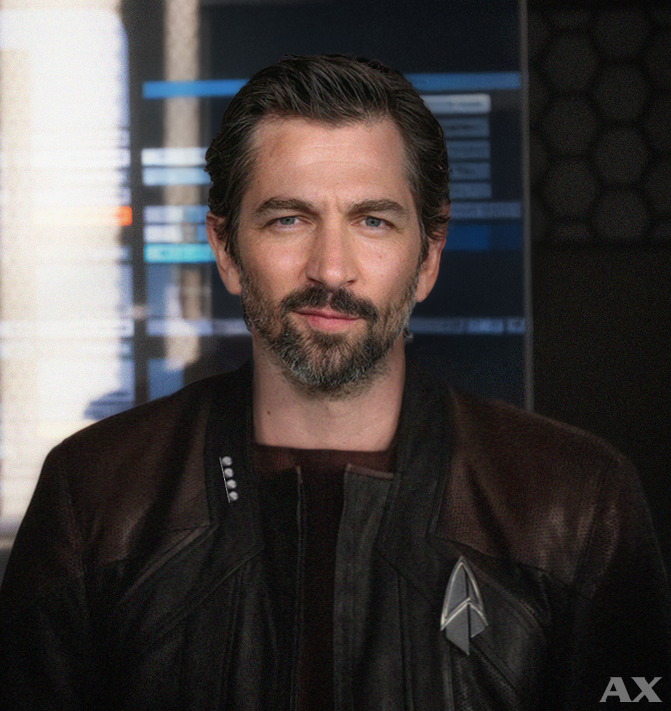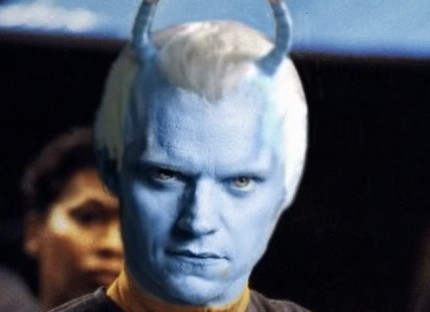Lieutenant Varyn K’lev looked at himself in the mirror, his green-skinned fingers touching the collar of his dress uniform, where now rested the two pips – and both solid, at that – of his new rank. “This still feels weird,” he said softly.
A hand on his shoulder drew his gaze as his Academy classmate and recent teammate, Ensign Ophelia Lotharys, joined him. “Command wouldn’t have promoted us if they didn’t have faith in us,” she said, the reassuring smile not quite reaching her eyes, though not for lack of trying.
“You two done cooing like Terran pigeons over those pips yet?” A gruff voice butted in as now-Midshipman Pelix, leaning against the wall, spoke up.
“Like you didn’t polish yours for today, Pelix,” interjected Teles Ghimir, now also wearing the insignia of a midshipman, with a twinkle in his eyes. Pelix huffed in reply, his brusque mien betrayed by the smile pulling at the corners of his mouth. While he certainly enjoyed ribbing the other members of the team over their shared new promotions, there was no denying his own pride.
Lieutenant K’lev rolled his eyes with a chuckle at the banter as he turned from the mirror and walked to the replicator in the antechamber. “Seven synthehols, please,” he said.
The replicator chirped, and a tray bearing seven glasses appeared. K’lev picked it up and carried it to a small table, motioning for everyone to gather around, then distributed the glasses – only seven for himself and his core team; Chief Petty Officer Robert Bong, who had been indispensable these last weeks, would have a small surprise role in the ceremony later, and would be serving as his Ops officer at least temporarily, was still aboard preparing things – and raised his own. “It’s been a ride, getting to where we are now, and we’ve still got more to learn, but there’s nobody I’d rather be on this journey with than you all. I can’t wait to see what comes next.”
K’lev looks around the group, making eye contact with each. “Here’s to us! Let’s go out there and show everyone who we are.” Seven glasses clinked together, then were drained and put down.
A few moments later, a Flag Aide stepped into the room. “They’re ready for you,” she said, then stepped aside so the septet could leave the room.
They stepped into the larger outer chamber, a gallery looking out into the docking facilities of Starbase 86. A crowd was gathered in the room, a ship’s company – well, at least part of one, only around 40 people – standing in formation facing a rostrum that stood before a window, with a small audience behind them and several dignitaries seated behind the podium. As Lieutenant K’lev and his companions walked to their places, the lieutenant by the rostrum with the dignitaries – which included several higher-ranking officers – and the rest in front of the crew, with Midshipmen sh’Livo, Hilava, and Ghimir each standing next to a training officer (or chief), K’lev looked out the gallery windows into the docking bay.
Floating in the docking bay opposite the windows was a California-class starship, the yellow markings on its hull identifying it as an engineering-support variant of the class. Here was the USS Culver City, now just over thirty years old, recently severely damaged but patched up, cleaned up, refitted, and ready to re-enter the fleet.
The recommissioning ceremony started; it was slated to be brief, but as full of pomp and circumstance as the current situation allowed. The first speaker was the commander of Task Force 86, Captain Cliff Pryce.
Captain Cliff Pryce stepped up to the podium, his steps steady but deliberate, like a man who had walked this kind of stage many times before. He rested his hands on the edges, taking in the faces before him, young, fresh uniforms mixed with older ones worn from years of service. His eyes lingered a moment on the ship beyond the canopy before he spoke.
“Ladies and gentlemen, I have been in Starfleet for over four decades. Long enough to know the difference between a ship that looks good in the records and a ship that gets the job done when it counts. The USS Culver City has always been the latter.
She has never been the newest or the fastest. She will not have her name carved into the great histories for winning a decisive battle or planting a flag on some untouched world. Her story has always been quieter than that. She is the one that slips in when power grids fail and whole stations hold their breath in the dark. She is the one that pulls a battered freighter out of the void, its crew hanging on by little more than hope. She is the one that restores life to a colony when the water runs dry.
Those missions do not fill headlines. But they save lives. And I can tell you, from my own years out there before the desk claimed me, it is those quiet victories that hold the Federation together.
Today, she returns to the fleet. She has fresh paint, a steady heart, and a crew with a fire in their eyes. You will not hear her name shouted in Council chambers or across subspace news. But somewhere, someone will breathe easier tonight because the Culver City was there when it mattered.
To her crew, I will tell you something I have learned over the years. A ship’s soul is not built in the yards. It is built in the mess halls at midnight, in the quiet moments between shifts, in the decisions you make when no one is watching. That will be your legacy.
You have long days ahead, and nights when you will wonder why you signed on. But you will also have moments when you will stand a little taller because you know you did something that mattered, even if no one else ever knows it.
Welcome back to the fleet,Culver City. Let us see what you can do.”
He gave the faintest nod toward Lieutenant K’lev, then stepped back from the podium. As he returned to his seat, his gaze drifted once more toward the ship, and for just a second, there was the look of a man who wished he was going with her.
After Captain Pryce finished speaking and the applause had died down, the master of ceremonies announced the second speaker, Task Force 86 executive officer Captain Jaya Thorne.
She spoke “Ladies and Gentlemen, esteemed officers, and honoured guests.
Today, we stand here not only to mark the rebirth of a vessel but to reaffirm a promise – a promise to uphold the highest ideals of Starfleet and the Federation. This ship we recommission today, the USS Culver City, is more than circuits and durasteel. She is a symbol of resilience, of duty, and of the unyielding spirit that defines every Starfleet officer who serves aboard her.
This ship has faced the void before. She has carried the hopes of countless souls across the stars. And today, she rises anew – refitted, rearmed, and recharged – ready to take on the challenges of an ever-changing galaxy.
But it’s not the hull or the hardware that will chart her course. It’s the people. The brave, the skilled, the relentless, who will breathe life into her decks and corridors. It is your dedication, courage, and unwavering commitment to the mission and to each other… that will turn this ship into a beacon of hope and strength.
We serve at a time when the stars hold as many questions as answers. When peace is fragile and danger often hides in shadow. And so, we recommit ourselves to exploration, to defense, and to the pursuit of justice.
As your Task Force Executive Officer, I ask each of you to carry that promise forward, not just today, but every day that ship sails. Together, you will face the unknown with clear eyes and steady hands. Together, you will write the next chapter of this ship’s storied legacy.
So set your sights on the horizon, step boldly into the future, and let this ship, once more, become a testament to all that Starfleet stands for.
Welcome home.”
Chief Bong, who has completed his tasks on the Culver City, had arrived just as Thorne had began her speech. He slung his trumpet under his arm and clapped with everyone else. Though he thought to himself ‘Way to upsell a secondary role support ship and crew on their importance ma’am, well done indeed’. Sincerely admiring the speech, but knowing deep down that it was atleast somewhat tongue in cheek.
Following Captain Thorne, the remaining speakers were the leader of the yard teams that prepared the Culver City for her return to service and the ship’s ceremonial sponsor (a relic of a tradition that dated back to Earth’s 20th century, if not further); given the short notice of the ceremony, no other speakers were available, and the speeches by the yard supervisor and the sponsor were short, but still poignant. After the ship’s sponsor finished, the master of ceremonies stepped to the rostrum. “And now, to address the crew and place the ship in commission, please welcome the commanding officer of the Culver City, Lieutenant Varyn K’lev.”
Lieutenant K’lev stepped up to the podium, looking out over the sea of people; suddenly very aware of a bead of sweat making its way down the back of his neck and his heart hammering in his chest, his grey eyes again found his team – his senior staff, or senior-staff-in-training. A smile from Ensign Lotharys, a thumbs-up from Midshipman Hilava, a nod from Midshipman Pelix… He felt his heart rate slow, and now calmer, Lieutenant K’lev started to speak. He hadn’t noticed Bong had arrived in the back with his trumpet yet, but he trusted the Chief was around somewhere.
“Thank you all for coming; you’ve heard several far better speeches already, so I’ll try to keep this short.” He chuckled, joined by a number of the audience. “We are here today to mark the recommissioning of the USS Culver City. I would like to thank everyone who played a role in the restoration of this ship for their hard work in getting her ready for today, whether structurally, systemically, institutionally, or bureaucratically; your efforts have made today possible.
“I would like to speak for a moment to the crew of the Culver City. This ship – our ship – may be made of duranium and transparent aluminum and dilithium and dozens of other materials, but we will decide what she is to become. Her personality, her quirks, her pride: these don’t come from fuel or phasers or sensors, but from all of us. While we may not be a front-line ship, our job is no less vital. Our job is to take the good and make it great, to fix what is damaged, and to restore what is broken, in whatever form that takes. Let us not forget, though, that at the heart of our job is people; not only the colonies in our area, but each other as well. I expect us all to look after each other, and our ship, as we look to our duties; if we do that, we will have done what we’re out here to do.”
He cleared his throat, then looked to the master of ceremonies, who returned his gaze with a nod. Lt. K’lev then took a deep breath and stood to attention. “Crew of the Culver City!” They stood to attention.
Now came Bong’s small part. He put the trumpet to his lips and played a rousing version of Reveille. Many of Culver City‘s crew had been cadets recently, or within the last few years at least. They all recalled hearing this played every morning before their first parade, often it was what many woke up hearing. It filled each of them pride and gave many goosebumps hearing that music at this time. It had created the exact ‘mood’ that K’lev and Bong had hoped it would when they had hatched the secret to play Reveille the night before.
On cue after Bong was done playing, a bosun blew the ships whistle ‘welcome aboard’ cadence.
“Man our ship and bring her to life!” K’lev called. Bong himself quickly disappeared up the ship’s gangway, eager to get back to the bridge and make sure the petty officers and crewman he had left there hadn’t broken anything while he was gone.
The crowd broke into applause as the crew, led by K’lev’s senior staff (and the training officers for three of them) quick-marched to a nearby open doorway and passed through it into the companionway that led to the Culver City’s port-side airlock on the primary hull. They flowed into the ship and dispersed; over the next few minutes, interior lights came up, formation lights lit and began blinking, and the nacelles began to glow as plasma started flowing through them. The nearby board, that identified the ships docked in this section of the station’s main bay, shifted as PCU Culver City (NCC-75573) became USS Culver City (NCC-75573), and the “Status” field changed from “Not In Service” to “Active.”
A viewscreen set up for the ceremony flickered to life, showing a wide-angle view of the bridge: Ensign Lotharys, also the executive officer, stood by the sciences station; Ensign Philips by the helm; Midshipman Pelix at the engineering console; Midshipman sh’Livo at tactical, accompanied by her training officer; Midshipman Hilava and her training officer – both wearing medical insignia – by the port-side turbolift doors; Midshipman Ghimir and his training officer near the aft auxiliary station; and CPO Bong joining them at the operations console. Lt. K’lev smiled, then turned to the assembled dignitaries and saluted. “USS Culver City is manned and awaiting your orders,” he declared to the crowd’s applause.
As the applause died down the yard master called out jokingly from the rostrum “Second star to the left, and straight on till morning, Lt!”.

 Bravo Fleet
Bravo Fleet













